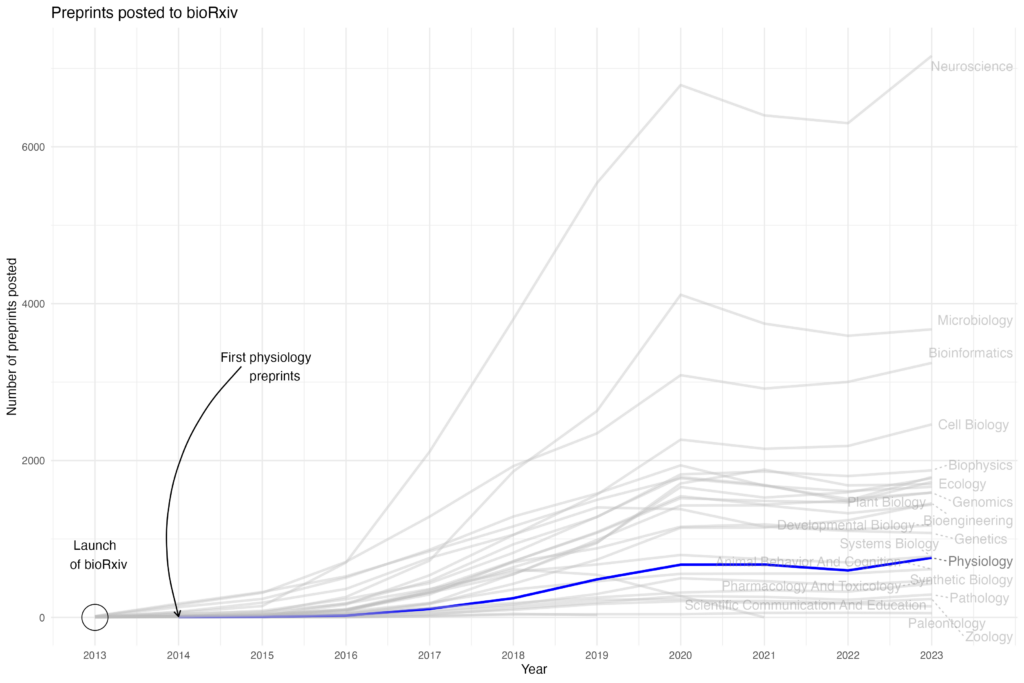
Physiology News Magazine
Physiology research in the era of preprints
News and Views
Physiology research in the era of preprints
News and Views
https://doi.org/10.36866/pn.133.14
Dr Sandra Franco-Iborra
ASAPbio Community Lead
Dr Pablo Ranea-Robles
Postdoctoral Fellow, Novo Nordisk Foundation Center for Basic Metabolic Research at the University of Copenhagen
Dr Lonni Besancon
Assistant Professor, Linköping University
Dr Jonathon Alexis Coates
Associate Director, ASAPbio
The authors are working in different disciplines, but all involved with ASAPbio (Accelerating Science and Publication in Biology) in the hope to increase the awareness and adoption of preprints and speed up the delivery of scientific results both within and outside of academia.
In the fast-paced world of scientific discovery, rapid dissemination of research findings is crucial for accelerating progress and knowledge sharing. However, the traditional publishing system hinders this process, leading to delays, increased costs, and limited access. Preprints, preliminary versions of scientific manuscripts that have not undergone formal peer review, have emerged as game-changers, dismantling barriers, and enabling immediate sharing of scientific ideas. The life sciences have gradually embraced this innovation, with bioRxiv and medRxiv gaining popularity. But in the field of physiology, the adoption of preprints lags behind. Unravelling the intricacies behind this slower uptake, we delve into key metrics of the current landscape and propose actionable strategies to bridge this gap and foster greater adoption.
Brief history of preprints
Preprints, originating from informal manuscript sharing, saw a significant shift with the advent of online repositories. ArXiv, established in 1991, accelerated research dissemination in physics. Despite biology’s initial slow adoption, the launch of bioRxiv in 2013 marked a turning point, with preprints now constituting about 10% of life sciences publications. While early initiatives, such as the NIH information exchange groups, faced resistance from journals (Cobb, 2017), the landscape has evolved, with preprints gaining acceptance from both journals and funding agencies. Some funders, like ASAP (Aligning Science Across Parkinson’s) and the Chan Zuckerberg Initiative, mandate preprint sharing before journal submission.
Preprints in physiology
While preprints are widely accepted in life sciences, their adoption in physiology has been slower. Compared to other disciplines, physiology remains on the lower end of posted preprints per year on bioRxiv (see Fig.1), with much lower download rates (Abdill and Blekhman, 2019). Even now, while neuroscientists share over 7,000 preprints per year, physiologists contribute hundreds. Additionally, the proportion of physiology preprints that have been published is lower (50.7%) than the global rate on bioRxiv (~70%), with many opting for closed (CCBY- NC-ND) licences (31%) or no licence at all (39%). Most physiology preprints are posted as a single version (77.6%), missing out on the advantage of updating them. These trends suggest reluctance among physiologists to openly share their research. While the reasons for this slower uptake are complex, the potential of preprints is undeniable. Could this open platform be the key to unlocking even faster advancements in our understanding of the human body? We firmly believe so. But what exactly makes preprints so valuable for the field of physiology?

Unleashing the power of preprints in physiology
Imagine amplifying the impact of your research, reaching wider audiences sooner, and accelerating scientific progress. Preprints offer all these benefits for physiologists, unlocking a world of possibilities. Studies show that preprinted articles attract more citations and attention than those directly published in journals (Fu and Hughey, 2019; Fraser et al., 2020). This increases visibility, particularly valuable for early career researchers, and can even lead to journal invitations. Preprints shift the power dynamic, empowering authors to share their work when ready and gather valuable feedback before submission. This can spark collaborations and refine manuscripts for stronger publications. Beyond individual benefits, preprints contribute to a more open and efficient scientific ecosystem. During the COVID-19 pandemic, nearly 40% of research (Fraser et al., 2021) was first shared as preprints, accelerating knowledge sharing (Besançon et al., 2021) and potentially saving lives. Compared to traditional publishing timelines that can take months, preprints appear online within days on platforms like bioRxiv, facilitating rapid dissemination. For instance, a 2021 preprint (Ghosh et al., 2021) highlighting a potential link between smoking and increased COVID-19 risk gained media attention six months before traditional publication, and potentially influenced public awareness. The advantages go beyond speed. Preprints decouple the quality of research from metrics like journal impact factor, promoting fairer evaluation. They also provide a platform for early-career researchers to showcase their work and gain recognition, fostering a more inclusive and diverse research landscape. Preprints are now accepted by most journals (including The Journal of Physiology, Experimental Physiology and Physiological Reports), making it easier to share your research in preprint repositories. Platforms like PREreview offer informal peer review before submission, helping refine your work and speed up publication. We recently ran the Crowd Preprint Review initiative, where 50 preprints received valuable feedback. Authors exchanged comments on bioRxiv, and even shifted their research focus based on the comments. Preprints can be also used to flip a traditional journal club and transform it into a preprint club, offering critical feedback directly to authors.
How to get started with preprints?
- Read a preprint
- Discuss a preprint at your next journal club or join/create a preprint review journal club
- Review a preprint
- Post a preprint when going to conferences or before submitting your next manuscript to a journal (The Journal of Physiology is part of the J2B service for direct submission)
Ready to accelerate your research, amplify your voice, and contribute to a more open, impactful physiology community? Don’t wait, grab our checklist below and explore the resources available at https://asapbio.org/. Join the preprint movement today!
References
Abdill RJ, Blekhman R (2019). Meta-Research: Tracking the popularity and outcomes of all bioRxiv preprints eLife 8: e45133. https://doi.org/10.7554/eLife.45133
Besançon L et al. (2021). Open science saves lives: lessons from the COVID-19 pandemic. BMC Med Res Methodol 21, 117. https://doi.org/10.1186/s12874-021-01304-y
Cobb M (2017). The prehistory of biology preprints: A forgotten experiment from the 1960s. PLoS Biology in PubMed 15(11): e2003995. https://doi.org/10.1371/journal.pbio.2003995
Fraser N et al. (2020). The relationship between bioRxiv preprints, citations and altmetrics. Quantitative Science Studies 2020; 1(2), 618–638. https://doi.org/10.1162/qss_a_00043
Fraser N et al. (2021). The evolving role of preprints in the dissemination of COVID-19 research and their impact on the science communication landscape. PLoS Biology in PubMed 19(4): e3000959. https://doi.org/10.1371/journal.pbio.3000959
Fu DY, Hughey JJ (2019). Releasing a preprint is associated with more attention and citations for the peer-reviewed article. eLife 8: e52646. https:// doi.org/10.7554/eLife.52646
Ghosh A et al. (2021). Combustible and electronic cigarette exposures increase ACE2 activity and SARS-CoV-2 Spike binding. bioRxiv https://doi.org/10.1101/2021.06.04.447156
